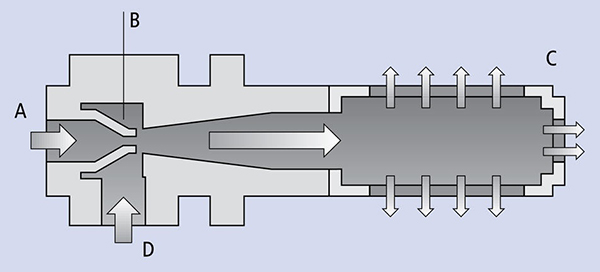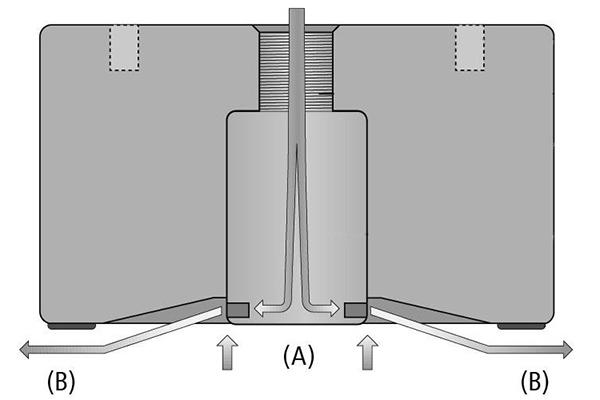Vacuum Generator Working Principle
Wed, Jan 12 by ATO.com
The vacuum generator is a high efficiency and small vacuum component that uses a positive pressure air source to generate negative pressure. This makes it necessary to use both positive and negative pressure in places where there is compressed air or in a pneumatic system. It is very easy and convenient to obtain negative pressure in places. Vacuum ejectors are widely used in industrial automation in the fields of machinery, electronics, packaging, printing, plastics and robotics. The following are the three working principles of vacuum generators.
Venturi principle
ATO.com vacuum generators are based on the Venturi principle.

- Compressed air is fed into the vacuum generator (A).
- As the cross section of the power nozzle (Venturi nozzle [B]) is reduced, the flow rate of the compressed air is increased. The dynamic pressure increases, while the static air pressure decreases at the same time.
- Once the compressed air passes through the power nozzle, the faster air will expand and create a vacuum.
- Air is inhaled into the vacuum generator through the vacuum port (D).
- The compressed air is discharged from the vacuum generator together with the inhaled air through the silencer (C).
Advantage:
- Vacuum generators that work according to the Venturi principle are especially suitable for very high acceleration environments.
- Vacuum grippers can be controlled individually.
- Design different types of vacuum generators for centralized and decentralized vacuum generation systems depending on the specific application.
- Various power levels suitable for different workpieces and applications.
- Can be used in all vacuum systems.
Bernoulli's principle

- Use integrated vacuum generator to achieve pneumatic operation.
- The compressed air is discharged from the holes in the suction cup, and the flow rate is significantly increased during the discharge process.
- As the speed increases, the static pressure drops and creates a vacuum (A) ("Bernoulli equation").
- The air with an increased flow rate is discharged from the side (B); an air cushion is created between the suspended vacuum suction cup and the workpiece.
- The high flow rate compensates for leakage, which means that even porous workpieces can be handled and separated.
Advantages:
- Under the Bernoulli Effect, the purpose of workpiece handling can be achieved with almost no contact.
- The vacuum generator based on Bernoulli principle can safely separate thin and porous workpiece.
Coanda principle
- Use integrated vacuum generator to achieve pneumatic operation.
- According to the Coanda principle, compressed air is introduced through an annular gap, which speeds up the flow rate of compressed air.
- The increase in flow rate produces the Coanda effect, where the discharged air flows along with the protruding surface.
- The air flowing along the surface then creates suction in the surrounding air (entrainment).
Advantages:
- Under the Coanda effect, the adsorption rate is high and the air consumption is low (working pressure only needs to be 1-5bar).
- The contact area is large and the vacuum opening is narrow to prevent the workpiece from being sucked or damaged.
- The adsorption area can also be partially fixed.

